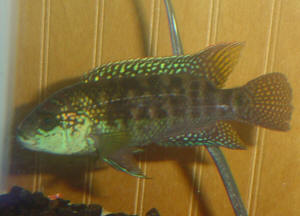|
FAQs on Jack
Dempseys Identification
Related Articles: Jack Dempseys, Oscars, Neotropical Cichlids, African Cichlids, Dwarf South American Cichlids, Cichlid Fishes in General,
Related FAQs: Jack
Dempseys 1, Jack Dempseys 2,
& FAQs on: Jack Jack Dempseys
Behavior, Jack Dempseys
Compatibility, Jack Dempseys
Selection, Jack Dempseys
Systems, Jack Dempseys Feeding,
Jack Dempseys Disease, Jack Dempseys Reproduction, &
Oscars 2, Neotropical Cichlids 1, Cichlids of the World, Cichlid Systems, Cichlid Identification, Cichlid Behavior, Cichlid Compatibility, Cichlid Selection, Cichlid Feeding, Cichlid Disease, Cichlid Reproduction,
|
 Hi ya Jack. Hi ya Jack.
|
Re: 70 Gallon Tank. EB Jack Dempsey ID...
8/5/10
HI again Neale!
<Lena,>
You have given me great advice, but I have one last question.
<Go for it.>
I have decided to go with an Electric Blue Jack Dempsey.
<An attractive fish in many ways.>
Can I keep him alone in my tank?
<Yes.>
There isn't much online about the EB Jack Dempsey, so I was hoping
that you could tell me.
<OK, here's the skinny. No-one is absolutely sure what this fish
is. For one thing, it doesn't breed true. In fact it usually
can't be bred at all, the fry being extremely delicate, assuming
the parents lay viable eggs at all, which they usually don't. It
appears that Electric Blue Jack Dempseys are produced by crossing one
Electric Blue with one regular JD. This would seem to imply that either
the Electric Blue JD is a non-fertile hybrid, which would be unusual
but not unknown among cichlids, or else the Electric Blue gene is a
mutant gene that is lethal when homozygous, but dominant when
heterozygous. So, there's a mystery there. Second mystery is that
these Electric Blue JDs aren't as big as the regular kind, about 5
inches/12 cm seems typical. Again, it could be that the Electric Blue
gene is harmful in some way, causing the fish to stay relatively small.
Or they could simply be a dwarf form without any other health problems.
Until we've kept them for a few years, we probably won't know
for sure. On the up side, they do also seem marginally more peaceful
than standard JDs, and get along well with robust catfish such as
Synodontis and Hypostomus. I've seen them in rough-and-tumble
community tanks too, but I think that's pushing your luck. But all
in all, these are mysterious fish with some curious "faults"
and cichlid aficionados have been a bit stand-offish about them,
worried they're another Parrot Cichlid or Flowerhorn.>
I love the look of a one fish aquarium, just one fish in the entire
tank. I have read that most people keep the normal JD alone or in
breeding pairs, so is that alright for the EBJD as well?
<Yes, they can be kept in pairs, but as stated, they probably
won't breed. Spawn yes, breed no.>
I hope so, because like I said, one fish in the tank is enough for me,
especially one so attractive.
<Whilst not to my taste, yes, these are very eye-catching fish. A
fishkeeping friend visited over the weekend and she keeps coral reef
fish and always comments my fish are all grey! Each to their own, I
suppose!>
Thanks again for all of your help! I don't know what I would do
without you! Lena
<I'm happy to help. Good luck, Neale.>
| I was wondering if you could help me identify
this fish... -- 10/30/2007 Hi, so grateful for your website, I
have looked everywhere for this fish, but could not find it. I
acquired this fish from someone who moved, could you help identify
this fish and any info you know about it. Thank you <Greetings.
This fish is the Jack Dempsey cichlid Cichlasoma octofasciatum. It
is a hardy, adaptable and very colourful species notorious for its
aggressive behaviour (hence its common name). Ideal conditions are
slightly hard (~15 degrees dH), neutral to slightly alkaline water
(~pH 7.5) around 25 C. It is one of the more carnivorous Central
American cichlids, feeding primarily on small benthic invertebrates
(worms, insect larvae, etc.) and small fish. In captivity, it will
usually eat most anything. A good quality carnivore flake or pellet
food is the ideal staple, augmented with suitable live or frozen
foods such as earthworms, chopped prawns, squid, etc. They
don't need "feeder fish" and these are a health risk
anyway. As with all cichlids, offering some plant food periodically
is a good idea. Sushi Nori, tinned peas, and frozen foods that
contain chopped spinach are recommended. It isn't difficult to
keep, but its large size (typically around 18-20 cm in captivity)
and territorial behaviour makes it a tricky inmate for community
tanks. It is best kept with other Central American cichlids, but
also works well with Tilapia of similar size. On the other hand,
mixing with South American cichlids or Rift Valley is a bad idea
because of differences in temperament and water chemistry
requirements. Be sure and read here:
http://www.wetwebmedia.com/FWSubWebIndex/dempseyfaqs.htm . Cheers,
Neale> |
|

|
|
|

